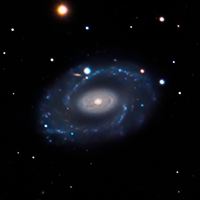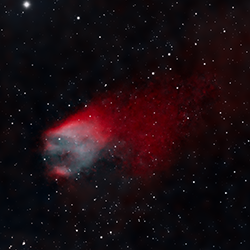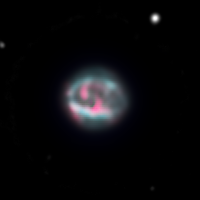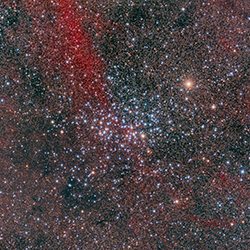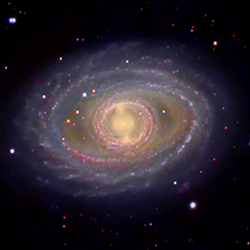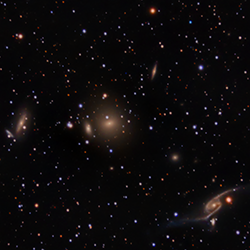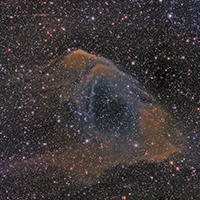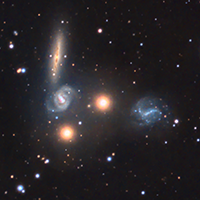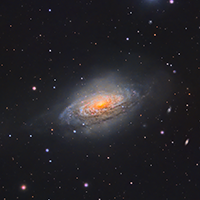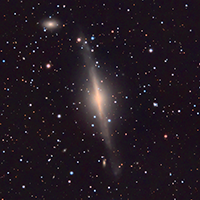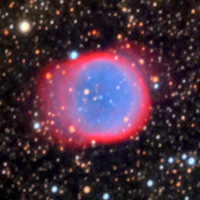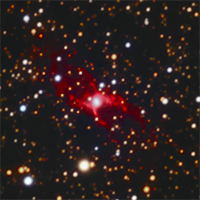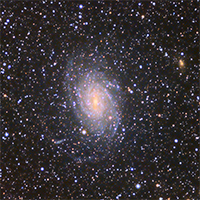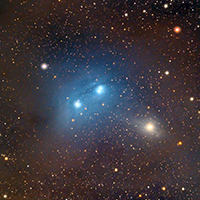A collection of astronomical photos taken by Adam Lundie at Eatons Hill Observatory.
Equipment Used:
- Telescope 1: Celestron 1100 Edge HD
- Telescope 2: Skywatcher Esprit 120ED
- Telescope 3: Skywatcher Black Diamond 80ED
- Mount: Skywatcher EQ8-Rh Pro
- Imaging Cameras: QSI 683ws-8 Monochrome, ZWO ASI290MM
- Filters: Astrodon Tru-Balance Gen 2 LRGB, Astronomik CLS-CCD, 6nm Hα, 6nm SII, 6nm OIII, ProPlanet 742nm IR-pass
- Guide Camera: Starlight Xpress Lodestar X2
- Guiding Optics: Skywatcher Evoguide 50ED, Innovations Foresight ONAG, Starlight Xpress Large Format Active Optics
- Focusers: Starlight Instruments Feather Touch + Posi Drive Motor
|
|
||
Recent Work:
23-Nov-2023
NGC 210 is a spiral galaxy in the constellation Cetus, situated roughly 70 million light-years from Earth. In this photograph, the galaxy's grand design is evident, with its pronounced spiral arms and central bulge standing out amidst a sea of stars. The spiral arms, speckled with regions of star formation, trace out from the bright core, while dark lanes of interstellar dust crisscross the galaxy, adding depth and contrast to the scene.
29-Sep-2022
When stars like the Sun are near end of life, they send their outer layers into space to create glowing clouds of gas, a planetary nebulae. This ejection of mass is uneven, and planetary nebulae can have complex shapes. This dying star is moving rapidly through space, resulting in a long tail of ionized hydrogen gas.
03-Jul-2022
Perhaps too small of an object for amateur equipment to tease out any details, I decided to try my luck on the Little Gem Nebula. NGC 6818 is roughly 6000 light-years away from Earth. The glow of the cloud is just over half a light-year across.
16-Jun-2022
First Calalogued in 1752, the NGC 3532, also known as the Wishing Well Cluster is an open cluster comprised of approximately 150 stars. It was also the first object ever observed by the Hubble Space Telescope. The bright orange star in the top right of the image is x Carinae (x Car), the brightest yellow hypergiant in the sky - 200,000 times as luminous as the Sun.
30-May-2022
NGC 1398 is a barred spiral galaxy with double ring structure 65 million light years distant.
29-Apr-2022
With more than 16 galaxies in one very narrow field of view, the elliptical galaxy NGC6876 is centered, interacting with NGC6877. In the bottom right, the spiral arms of NGC6872 are spread out by the interaction with IC4970
30-Mar-2022
Although categorised as a hydrogen emission nebula, Sh2-63 lacks the bright red colouring typical of similar objects.
08-Nov-2021
This interacting trio of galaxies is known as the Lyon Group of Galaxies 455, made up of the galaxies NGC 7233 (middle), NGC 7232 (upper), and NGC 7232B (right).
10-Aug-2021
NGC 3521 is a flocculent spiral galaxy located 26 million light-years away from Earth
23-Jul-2021
NGC 5068 is a seldom photographed face-on galaxy sporting a bright central bar with diffuse spiral arms containing areas of pink hydrogen nebulosity and star-forming regions.
12-Jun-2021
Categorised as a supermassive disk galaxy, at a distance of 80 million light years and 200,000 light years across, NGC 5084 is one of the largest galaxies in the Virgo Supercluster. Seen edge on, the warped disk is a result of stealing material from nearby satellite galaxies.
15-Feb-2021
Stars such as our Sun do not contain enough mass to finish their lives in the glorious explosions known as supernovae. However, they are still able to salute their imminent demise into dense, Earth-sized embers called white dwarfs by first expelling colourful shells of gas known as planetary nebulae.
26-Nov-2020
The Red Spider Nebula (also catalogued as NGC 6537) is a planetary nebula located near the heart of the Milky Way.
21-Nov-2020
NGC 6744 (Caldwell 101) is a spiral galaxy about 31 million light-years away, tilted towards our line of sight. It is thought to be one of the most Milky Way-like spiral galaxies in our immediate vicinity. It also has at least one distorted companion galaxy similar to the Magellanic Clouds.
13-Oct-2020
IC 4601 is a reflection nebula within the larger Blue Horsehead Nebula. Reflection nebulae are actually made up of dust that normally appears dark but can reflecting the light of nearby stars.
